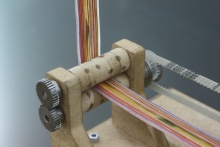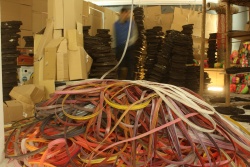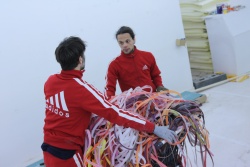Das Band - Polyethylene Extruder
Bearbeiten von „YNNOK“ Wechseln zu: Navigation, Suche Wikitext Vorschau Änderungen FettKursiv Signatur und ZeitstempelLinkEingebettete DateiQuellenangabe ErweitertSonderzeichenHilfe
| Das Band - Polyethylene Extruder Release status: stable [box doku] | |
|---|---|

| |
| Description | A Band making machine. |
| Author(s) | A.B. (Bilex) |
| Platform | Sophistication |
== Information == Das Band is a multicolored LD-PE ribbon. It is flexible but durable, has a nice smooth surface and can be cut into pieces easily. This assures high adaptability in many thousand applications. It was manufactured within two weeks in line with the Big Banana factory. Dimensions: 1,5mm x 15mm x ~250.000mm Material: Riblene® MV10 ==Processing== The Extruder is the machine creating das Band. It works similar to those machines known from industrial production of plastic pipes, sheets and profiles. A turning screw (here: ordinary 20mm drill bit) takes plastic pellets from a feed hopper and squeeze them through a die. While in industrial machines the energy is provided by shear strain and high pressure, this machine works with an heating area where the pellets start to melt. After inserting energy into the material, it needs to be cooled down after leaving the die immediately to bring it into shape. (This loss of energy is a general problem during the extrusion process, even in industrial processing.) Several rotating rolls work as a shaping unit. ==The Machine== ===Motor & Gear & Housing=== First tests were made with a low-budget gearmotor found on ebay. Those are advertised with high torque rates. A closer look at the data sheet shows that sometimes these numbers are the stall values. That means: No rotation at given load. The required torque for proper operation was not known before and there was no clue how to calculate it. The motor not only needs to press the material through the pipe and the die, sometimes the drill needs to cut pellets on their way from the hopper inside the heating pipe. That means that the required power depends on the used material. The first test-material was a gift from the plastic lab of the University Duisburg Essen. They gave us a whole 25kg bag for testing purpose. Unfortunately the material was not suitable for processing it in a selfmade-extruder due to its low MFI (Melt-flow-index) value. Even with very high temperatures the material did not become liquid as expected. Even without a die the first testing drivetrain nearly stalled. After that failure I met Helmut at the Labor. Helmut is a polymere expert. He advised me to try a PE with a higher MFI. He recommended me to contact a well-known local plastic company in order to ask for a helping hand. A few days later another 25kg PE bag with PE pellets inside (amazing: PE pellets packed in a PE bag.) arrived at the Labor. Within these days I found a 120V gearmotor in the Labor basement. Someone told me it was used as mechanical switch in a high voltage application. This means: The device temperature may increase during continuous operation. Finally the motor was operated with 15V and there where no thermal problems at all. Although the motor is very big and seems to be very powerful (no datasheet or further information available) a gear box was added to increase torque by lowering the speed of rotation. The gearbox was manufactured by using the Labor CNC-Fräse. This was the most intense adventure I experienced with the machine so far. Proper gears and a solid housing are important to handle the power of the transmission. According to the power consumption and the speed of rotation the torque is approx. 10Nm during normal operation and using the high MFI LD-PE.
===Heating Unit===
===Die=== ===Shaping Unit=== == Distribution ==
== Video == Video on Youtube
Zusammenfassung:
Nur Kleinigkeiten wurden verändert Diese Seite beobachten
Bitte kopiere keine Webseiten, die nicht deine eigenen sind, benutze keine urheberrechtlich geschützten Werke ohne Erlaubnis des Urhebers! Du gibst uns hiermit deine Zusage, dass du den Text selbst verfasst hast, dass der Text Allgemeingut (public domain) ist, oder dass der Urheber seine Zustimmung gegeben hat. Falls dieser Text bereits woanders veröffentlicht wurde, weise bitte auf der Diskussionsseite darauf hin. Bitte beachte, dass alle LaborWiki-Beiträge automatisch unter der „GNU Free Documentation License 1.2“ stehen (siehe LaborWiki:Urheberrechte für Einzelheiten). Falls du nicht möchtest, dass deine Arbeit hier von anderen verändert und verbreitet wird, dann klicke nicht auf „Seite speichern“. Abbrechen
Die folgende Vorlage wird auf dieser Seite verwendet: Navigationsmenü
Bilex Diskussion Einstellungen Beobachtungsliste Beiträge Abmelden
Seite Diskussion
Lesen Bearbeiten Versionsgeschichte Beobachten
Labor Hauptseite Projekte Labor Wiki Labor Blog Labor Planet Labor Github
Wiki
Startseite Termine Kontakt Über uns Wiki-Einführung Letzte Änderungen
Werkzeuge
Links auf diese Seite Änderungen an verlinkten Seiten Datei hochladen Spezialseiten Seiteninformationen
Datenschutz Über LaborWiki Impressum
GNU Free Documentation License 1.2 Powered by MediaWiki



